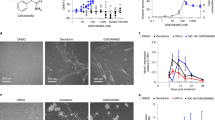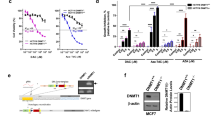Abstract
Purpose
Currently approved DNA hypomethylating nucleosides elicit their effects in part by depleting DNA methyltransferase I (DNMT1). However, their low response rates and adverse effects continue to drive the discovery of newer DNMT1 depleting agents. Herein, we identified two novel 2′-deoxycytidine (dCyd) analogs, 4′-thio-2′-deoxycytidine (T-dCyd) and 5-aza-4′-thio-2′-deoxycytidine (aza-T-dCyd) that potently deplete DNMT1 in both in vitro and in vivo models of cancer and concomitantly inhibit tumor growth.
Methods
DNMT1 protein levels in in vitro and in vivo cancer models were determined by Western blotting and antitumor efficacy was evaluated using xenografts. Effects on CpG methylation were evaluated using methylation-specific PCR. T-dCyd metabolism was evaluated using radiolabeled substrate.
Results
T-dCyd markedly depleted DNMT1 in CCRF-CEM and KG1a leukemia and NCI-H23 lung carcinoma cell lines, while it was ineffective in the HCT-116 colon or IGROV-1 ovarian tumor lines. On the other hand, aza-T-dCyd potently depleted DNMT1 in all of these lines indicating that dCyd analogs with minor structural dissimilarities induce different DNMT1 turnover mechanisms. Although T-dCyd was deaminated to 4′-thio-2′-deoxyuridine, very little was converted to 4′-thio-thymidine nucleotides, suggesting that inhibition of thymidylate synthase would be minimal with 4′-thio dCyd analogs. Both T-dCyd and aza-T-dCyd also depleted DNMT1 in human tumor xenografts and markedly reduced in vivo tumor growth. Interestingly, the selectivity index of aza-T-dCyd was at least tenfold greater than that of decitabine.
Conclusions
Collectively, these data show that 4′-thio modified dCyd analogs, such as T-dCyd or aza-T-dCyd, could be a new source of clinically effective DNMT1 depleting anticancer compounds with less toxicity.





Similar content being viewed by others
References
Brown KD, Robertson KD (2007) DNMT1 knockout delivers a strong blow to genome stability and cell viability. Nat Genet 39:289–290
Esteller M, Corn PG, Baylin SB, Herman JG (2001) A gene hypermethylation profile of human cancer. Cancer Res 61:3225–3229
Jones PA, Baylin SB (2007) The epigenomics of cancer. Cell 128:683–692
Baylin SB, Ohm JE (2006) Epigenetic gene silencing in cancer—a mechanism for early oncogenic pathway addiction? Nat Rev Cancer 6:107–116
Ooi SK, O’Donnell AH, Bestor TH (2009) Mammalian cytosine methylation at a glance. J Cell Sci 122:2787–2791
Wu J, Issa JP, Herman J, Bassett DE Jr, Nelkin BD, Baylin SB (1993) Expression of an exogenous eukaryotic DNA methyltransferase gene induces transformation of NIH 3T3 cells. Proc Natl Acad Sci USA 90:8891–8895
Vertino PM, Issa JP, Pereira-Smith OM, Baylin SB (1994) Stabilization of DNA methyltransferase levels and CpG island hypermethylation precede SV40-induced immortalization of human fibroblasts. Cell Growth Differ 5:1395–1402
Bakin AV, Curran T (1999) Role of DNA 5-methylcytosine transferase in cell transformation by fos. Science 283:387–390
Robert MF, Morin S, Beaulieu N, Gauthier F, Chute IC, Barsalou A, MacLeod AR (2003) DNMT1 is required to maintain CpG methylation and aberrant gene silencing in human cancer cells. Nat Genet 33:61–65
Laird PW, Jackson-Grusby L, Fazeli A, Dickinson SL, Jung WE, Li E, Weinberg RA, Jaenisch R (1995) Suppression of intestinal neoplasia by DNA hypomethylation. Cell 81:197–205
Belinsky SA, Klinge DM, Stidley CA, Issa JP, Herman JG, March TH, Baylin SB (2003) Inhibition of DNA methylation and histone deacetylation prevents murine lung cancer. Cancer Res 63:7089–7093
Milutinovic S, Knox JD, Szyf M (2000) DNA methyltransferase inhibition induces the transcription of the tumor suppressor p21(WAF1/CIP1). J Biol Chem 275:6353–6359
Milutinovic S, Brown SE, Zhuang Q, Szyf M (2004) DNA methyltransferase 1 knock down induces gene expression by a mechanism independent of DNA methylation and histone deacetylation. J Biol Chem 279:27915–27927
Egger G, Jeong S, Escobar SG, Cortez CC, Li TW, Saito Y, Yoo CB, Jones PA, Liang G (2006) Identification of DNMT1 (DNA methyltransferase 1) hypomorphs in somatic knockouts suggests an essential role for DNMT1 in cell survival. Proc Natl Acad Sci USA 103:14080–14085
Agoston AT, Argani P, Yegnasubramanian S, De Marzo AM, Ansari-Lari MA, Hicks JL, Davidson NE, Nelson WG (2005) Increased protein stability causes DNA methyltransferase 1 dysregulation in breast cancer. J Biol Chem 280:18302–18310
Zhou Q, Agoston AT, Atadja P, Nelson WG, Davidson NE (2008) Inhibition of histone deacetylases promotes ubiquitin-dependent proteasomal degradation of DNA methyltransferase 1 in human breast cancer cells. Mol Cancer Res 6:873–883
Ghoshal K, Datta J, Majumder S, Bai S, Kutay H, Motiwala T, Jacob ST (2005) 5-Aza-deoxycytidine induces selective degradation of DNA methyltransferase 1 by a proteasomal pathway that requires the KEN box, bromo-adjacent homology domain, and nuclear localization signal. Mol Cell Biol 25:4727–4741
Patel K, Dickson J, Din S, Macleod K, Jodrell D, Ramsahoye B (2010) Targeting of 5-aza-2′-deoxycytidine residues by chromatin-associated DNMT1 induces proteasomal degradation of the free enzyme. Nucleic Acids Res 38:4313–4324
Santi DV, Norment A, Garrett CE (1984) Covalent bond formation between a DNA-cytosine methyltransferase and DNA containing 5-azacytosine. Proc Natl Acad Sci USA 81:6993–6997
Beumer JH, Parise RA, Newman EM, Doroshow JH, Synold TW, Lenz HJ, Egorin MJ (2008) Concentrations of the DNA methyltransferase inhibitor 5-fluoro-2′-deoxycytidine (FdCyd) and its cytotoxic metabolites in plasma of patients treated with FdCyd and tetrahydrouridine. Cancer Chemother Pharmacol 62:363–368
Marquez VE, Barchi JJ Jr, Kelley JA, Rao KV, Agbaria R, Ben-Kasus T, Cheng JC, Yoo CB, Jones PA (2005) Zebularine: a unique molecule for an epigenetically based strategy in cancer chemotherapy. The magic of its chemistry and biology. Nucleosides, Nucleotides Nucleic Acids 24:305–318
Parker WB, Shaddix SC, Rose LM, Waud WR, Shewach DS, Tiwari KN, Secrist JA III (2000) Metabolism of 4′-thio-beta-D-arabinofuranosylcytosine in CEM cells. Biochem Pharmacol 60:1925–1932
Thottassery JV, Tiwari KN, Westbrook L, Secrist JA III, Parker WB (2011) Novel 2′-deoxycytidine analogs as DNA demethylation agents. Proc Am Assoc Cancer Res 71:2537. doi:10.1158/1538-7445.AM2011-2537
Secrist JA III, Tiwari KN, Riordan JM, Montgomery JA (1991) Synthesis and biological activity of 2′-deoxy-4′-thio pyrimidine nucleosides. J Med Chem 34:2361–2366
Tiwari KN, Cappellacci L, Montgomery JA, Secrist JA III (2003) Synthesis and anti-cancer activity of some novel 5-azacytosine nucleosides. Nucleosides, Nucleotides Nucleic Acids 22:2161–2170
Someya H, Shaddix SC, Tiwari KN, Secrist JA III, Parker WB (2003) Phosphorylation of 4′-thio-beta-D-arabinofuranosylcytosine and its analogs by human deoxycytidine kinase. J Pharmacol Exp Ther 304:1314–1322
Herman JG, Graff JR, Myohanen S, Nelkin BD, Baylin SB (1996) Methylation-specific PCR: a novel PCR assay for methylation status of CpG islands. Proc Natl Acad Sci USA 93:9821–9826
Dodge JE, Munson C, List AF (2001) KG-1 and KG-1a model the p15 CpG island methylation observed in acute myeloid leukemia patients. Leuk Res 25:917–925
Kumar S, Horton JR, Jones GD, Walker RT, Roberts RJ, Cheng X (1997) DNA containing 4′-thio-2′-deoxycytidine inhibits methylation by HhaI methyltransferase. Nucleic Acids Res 25:2773–2783
Herman JG, Civin CI, Issa JP, Collector MI, Sharkis SJ, Baylin SB (1997) Distinct patterns of inactivation of p15INK4B and p16INK4A characterize the major types of hematological malignancies. Cancer Res 57:837–841
Dodge JE, List AF, Futscher BW (1998) Selective variegated methylation of the p15 CpG island in acute myeloid leukemia. Int J Cancer 78:561–567
Verri A, Focher F, Duncombe RJ, Basnak I, Walker RT, Coe PL, de Clercq E, Andrei G, Snoeck R, Balzarini J, Spadari S (2000) Anti-(herpes simplex virus) activity of 4′-thio-2′-deoxyuridines: a biochemical investigation for viral and cellular target enzymes. Biochem J 351(Pt 2):319–326
Rogstad DK, Herring JL, Theruvathu JA, Burdzy A, Perry CC, Neidigh JW, Sowers LC (2009) Chemical decomposition of 5-aza-2′-deoxycytidine (Decitabine): kinetic analyses and identification of products by NMR, HPLC, and mass spectrometry. Chem Res Toxicol 22:1194–1204
Esteve PO, Chin HG, Benner J, Feehery GR, Samaranayake M, Horwitz GA, Jacobsen SE, Pradhan S (2009) Regulation of DNMT1 stability through SET7-mediated lysine methylation in mammalian cells. Proc Natl Acad Sci USA 106:5076–5081
Parker WB, Shaddix SC, Rose LM, Tiwari KN, Montogmery JA, Secrist JA III, Bennett LL Jr (1995) Metabolism and metabolic actions of 4′-thiothymidine in L1210 cells. Biochem Pharmacol 50:687–695
Someya H, Waud WR, Parker WB (2006) Long intracellular retention of 4′-thio-arabinofuranosylcytosine 5′-triphosphate as a critical factor for the anti-solid tumor activity of 4′-thio-arabinofuranosylcytosine. Cancer Chemother Pharmacol 57:772–780
Richardson KA, Vega TP, Richardson FC, Moore CL, Rohloff JC, Tomkinson B, Bendele RA, Kutcha RD (2004) Polymerization of the triphosphates of araC, 2′,2′-difluorodeoxycytidine (dFdC) and OSI-7836 (T-araC)by human DNA polymerase alpha and DNA primase. Biochem Pharmacol 68:2337–2346
Acknowledgments
We thank Dr. Mark Suto for careful review of the manuscript. We also thank Dr. Joel Morris for T-dCyd synthesis and Dr. Robert J. Kinders for providing tumor lysates from T-dCyd-treated mice. The content of this publication does not necessarily reflect the views or policies of the Department of Health and Human Services, nor does mention of trade names, commercial products or organizations imply endorsement by the US Government. NCI-Frederick and Southern Research Institute are accredited by AAALAC International and follows the Public Health Service Policy for the Care and Use of Laboratory Animals. Animal care was provided in accordance with the procedures outlined in the “Guide for Care and Use of Laboratory Animals” (National Research Council; 2010; National Academy Press; Washington, D.C.). Work described in this report was funded by NIH Grant # P01 CA34200, NCI contract N01-CO-12400, the ADDA (Alabama Drug Discovery Alliance) and the UAB Center for Clinical and Translational Science under 5UL1 RR025777.
Conflict of interest
None.
Author information
Authors and Affiliations
Corresponding authors
Rights and permissions
About this article
Cite this article
Thottassery, J.V., Sambandam, V., Allan, P.W. et al. Novel DNA methyltransferase-1 (DNMT1) depleting anticancer nucleosides, 4′-thio-2′-deoxycytidine and 5-aza-4′-thio-2′-deoxycytidine. Cancer Chemother Pharmacol 74, 291–302 (2014). https://doi.org/10.1007/s00280-014-2503-z
Received:
Accepted:
Published:
Issue Date:
DOI: https://doi.org/10.1007/s00280-014-2503-z




